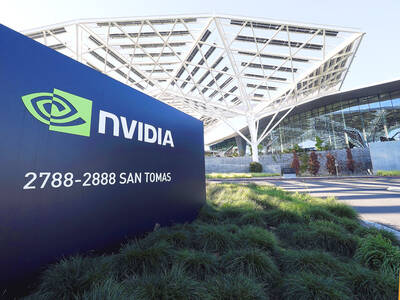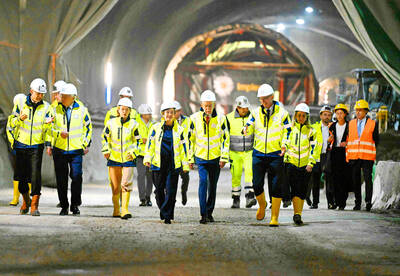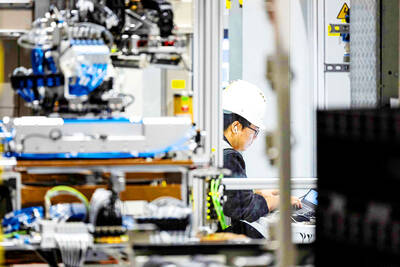The Taiwan High-Speed Rail Corp (THSRC,
She said the new financial plan was not a dramatic development. The launch of the troubled project has been delayed for a year until the end of next October, and the government has ordered two public foundations to pour in more money to save the financially troubled corporation.
Asked if the THSRC would need further fresh investment before it launches the service, she did not give a clear answer, adding only that "the financial plan is not yet finalized."
The NT$7.5 billion (US$223 million) that the China Aviation Development Foundation (航發會) and the China Technical Consultants Incorporated Foundation (中技社) were told to invest in the BOT (build, operate, transfer) project became the focus of controversy.
Both the media and opposition lawmakers have criticized the project, while some experts are expressing concern that the project might become a money trap that will end up using enormous amounts of taxpayers' money.
Ing said she knew China Technical was not happy about being "forced" to make the investment to make up for the THSRC's financial shortfall.
When the project started, the stock market was performing well and investors were confident about the nation's economic future, she said.
However, the overall economic situation had changed over the past few years, making it difficult for the THSRC to attract new investment, she said.
Ing said there was no need to move the corporation's next board meeting forward to discuss a reshuffle of board members.
The government has asked that three seats be added to the 12-member board, with two appointed by the government and the other chosen by a consensus between the government and the THSRC. The Ministry of Transportation and Communications has said it hopes the board meeting can be held this month.
However, Ing said that it takes two months to prepare for a board meeting and that since a regular meeting is scheduled for May, there was no need to hold a provisional one.
She said that the percentage of government investment had not reached a level that entitled it to take over the project, and added that the government could only take over the corporation if it were declared bankrupt.
She added that this meant the government would have around six months to locate another management team that could win assurances from the consortium of banks connected to the project.
In her view, she said, the government has neither the capacity nor the willingness to take over the high-speed rail project.
Meanwhile, reported subsidence in Yunlin County will not pose a danger to the high-speed rail, Ing said.
The overuse of groundwater by local farmers and factory managers is causing land to subside at an average of 10cm per year, leading some to worry that the safety of the railway segment in Yunlin will be compromised.
Ing said that the subsidence will not affect the safety of the high-speed trains, though at the current speed, she said, parts of Yunlin are subsiding so rapidly that in 200 years whole areas might simply disappear.
"That is a question much more serious than the safety of high-speed trains," she said.
She said engineers and workers had taken into account the subsidence when they laid the foundations for the railway, and that there was no risk involved.

CHIP RACE: Three years of overbroad export controls drove foreign competitors to pursue their own AI chips, and ‘cost US taxpayers billions of dollars,’ Nvidia said China has figured out the US strategy for allowing it to buy Nvidia Corp’s H200s and is rejecting the artificial intelligence (AI) chip in favor of domestically developed semiconductors, White House AI adviser David Sacks said, citing news reports. US President Donald Trump on Monday said that he would allow shipments of Nvidia’s H200 chips to China, part of an administration effort backed by Sacks to challenge Chinese tech champions such as Huawei Technologies Co (華為) by bringing US competition to their home market. On Friday, Sacks signaled that he was uncertain about whether that approach would work. “They’re rejecting our chips,” Sacks

NATIONAL SECURITY: Intel’s testing of ACM tools despite US government control ‘highlights egregious gaps in US technology protection policies,’ a former official said Chipmaker Intel Corp has tested chipmaking tools this year from a toolmaker with deep roots in China and two overseas units that were targeted by US sanctions, according to two sources with direct knowledge of the matter. Intel, which fended off calls for its CEO’s resignation from US President Donald Trump in August over his alleged ties to China, got the tools from ACM Research Inc, a Fremont, California-based producer of chipmaking equipment. Two of ACM’s units, based in Shanghai and South Korea, were among a number of firms barred last year from receiving US technology over claims they have

It is challenging to build infrastructure in much of Europe. Constrained budgets and polarized politics tend to undermine long-term projects, forcing officials to react to emergencies rather than plan for the future. Not in Austria. Today, the country is to officially open its Koralmbahn tunnel, the 5.9 billion euro (US$6.9 billion) centerpiece of a groundbreaking new railway that will eventually run from Poland’s Baltic coast to the Adriatic Sea, transforming travel within Austria and positioning the Alpine nation at the forefront of logistics in Europe. “It is Austria’s biggest socio-economic experiment in over a century,” said Eric Kirschner, an economist at Graz-based Joanneum

France is developing domestic production of electric vehicle (EV) batteries with an eye on industrial independence, but Asian experts are proving key in launching operations. In the Verkor factory outside the northern city of Dunkirk, which was inaugurated on Thursday, foreign specialists, notably from South Korea and Malaysia, are training the local staff. Verkor is the third battery gigafactory to open in northern France in a region that has become known as “Battery Valley.” At the Automotive Energy Supply Corp (AESC) factory near the city of Douai, where production has been under way for several months, Chinese engineers and technicians supervise French recruits. “They